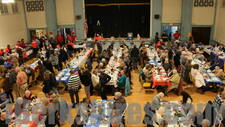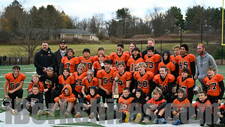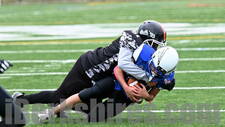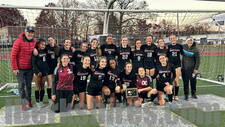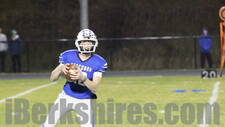Bytes from the Bean by Joe Manning 9-1-0112:00AM / Saturday, September 01, 2001
FIVE YEARS
"Why should it be loved as a city? It's never the same city for a dozen years all together. A man born forty years ago finds nothing, absolutely nothing of the New York he knew. If he chances to stumble upon a few old houses not yet leveled, he is fortunate. But the landmarks, the objects which marked the city to him as a city are gone."
-Harper's Monthly, circa 1890
Several months ago, Commonwealth Sprague announced that it is planning to pack up its capacitors and cross the Rio Grande by the end of the year. At the same time, it was reported that American Annuities, the landlord, plans to tear down the factory next spring.
On Tuesday, August 14, after morning coffee and chatter at the Bean, I walked up Marshall Street and down River Street to take some pictures. It seems like I am always collecting photos for my ever-growing scrapbook of things that aren't there anymore. You get 'em while you can. They've been coming down with great regularity for the past few decades.


With a bright late-morning sun behind me, I walked back and forth on Brown Street for over an hour, changing lenses frequently and sometimes straying into the fenced-off parking lot. Several employees taking a smoke break at a picnic table asked me what I was looking for. The large brick building appears rather ordinary as factories go, but through the camera lens, one can spot little gems of faded beauty and curious bits of industrial architecture.


According to my sources, the mill was built by Sylvander Johnson in 1872 after his Johnson Manufacturing Company, which was a warp mill, burned down on the site. Johnson converted his business to a print mill specializing in gingham. He died in 1882, and ten years later, his son W.S. Johnson sold it to Ducan D. Parmly of New York, who built an adjoining structure called the Dunbar Mill. After several more changes in ownership, Sprague Specialties Company bought it in 1937, and it became known locally as the Brown Street plant. Commonwealth Sprague took over when Sprague went out in the 1980s, and they currently lease the building from Sprague's parent owner American Annuities.

I wasn't thinking about all that stuff when I took the pictures. I just wondered if the empty space will look like a burial ground next year, ironically just over the railroad tracks from Hillside Cemetery. I will miss the great views of the mill and smokestack from the cemetery.


I was also thinking that it was a very special day for me. Exactly five years ago on August 14, I drove up very early in the morning to North Adams by myself for the first time to write about the city. I sat at the Bean and stared at the street and the unfamiliar people who walked by or came in for coffee. That was just three months after the Bean had opened and the legendary Capitol Restaurant had served its last meal. The theme of the Fall Foliage Parade this year is, "Changing spaces, changing faces." But it was already happening in 1996.
I had planned to celebrate this five-year anniversary by driving in quietly and anonymously and walking around by myself, as if I were discovering the city all over again. I hadn't been in town for two minutes before I realized that I am not a stranger anymore. Later in the day, I sat alone on the sound art speaker under Route 2 and wrote down a few of the things that have changed in those five years.
What's gone? Milltown Studios, Gateway Clothing, Breen's Flowers, Jack's Army-Navy, Lady Di Restaurant, Due Baci, the Mocha Shoppe, the back of Newberry's, two buildings on Eagle Street north of Molly's, the house at the corner of Prospect and Eagle, the row house at the bottom of North Holden, Joe Bianco, Julia White, and Tony Talarico.
What's new? Mayor's Downtown Celebration, BrewHaHa, Gramercy Bistro, Steeples Restaurant, Papyri Books, Everything Art, 55 Main Street, Main Street Stage, Tangiers, Hickory Bill's, Il Tesoro, luxury apartments in the Blackinton Block, Atef Jewelers, Joga Cafe, Adams Cooperative Bank on Eagle Street, Flatiron Gallery, Skiddoo, Landmark Credit Union on Ashland Street, MASS MoCA, Kleiser-Walczak, The Advocate office at MASS MoCA, Eziba, The Porches Inn, NorthAdams.com, Tunnel City Gallery, and the incredible North Adams Museum of History and Science (where I was able to find out about the Brown Street plant in just a couple of minutes with the kind help of Deb Sprague).
What's coming? The new park on River Street, expansion of the North Adams Public Library, Phase Two of MASS MoCA, restoration of the Mohawk Theater, the Hoosac Bank/New Kimbell Block redevelopment, and an attractive and newly designed Center Street.
That's a lot of changes in five years. Most of it is for the better. At the Bean, the old-timers often talk about the "good old days," and they have a lot of wonderful memories. But residents who grew up in the '70s and '80s may see it a little differently.
Carl Robare, who grew up in North Adams in the '20s and '30s, gives us a lot to think about in his interview in Disappearing Into North Adams:
"There was a little garage on Alton Place that my dad built with hand tools. It had a hip roof. I looked at it one day just before they tore it down, and I said to myself, 'My father built that.' It was sad, but it was from a different time, and it's gone. Now the area is flat. It's against the riverbank where the flood control is. I can still imagine all those little houses sloping down to the river with the rocks and dirt and crappy stuff in it. It was a different life then.
I have a picture of a home my grandparents lived in over near the Braytonville Mill. It was a bunch of little hovels built on a slope going down to the mill. My grandparents had their first two or three children there. Can you imagine them looking back many years later and saying: 'Gee, we used to live there. That was nice. We were just kids then, and we had a couple of children. We lived in a hovel in poverty and worked our heads off eighty hours a week in the mill. Wasn't that wonderful?'
You can remember the past, but you can't recreate it. And what one person remembers as being great, another remembers as being terrible. Did you ever go back years later to someplace you thought was really nice when you were a kid and ask yourself, 'Why did I think that was nice?'
Some people can look back and say, 'Things are not the same.' Of course they're not the same. If you look at the old utility maps of North Adams in the late 1800s, you can see that the sewers came up the streets, and there were three or four places where they all just dumped into the river. Looking at the improvements in the river and the air and the other things in town, I would say that North Adams is a thousand percent better than it was then."
As my friend Shirley Davis says, "The good old days are now."
Visit Joe's website at: www.sevensteeples.com.
Email Joe at: manningfamily@rcn.com
|











